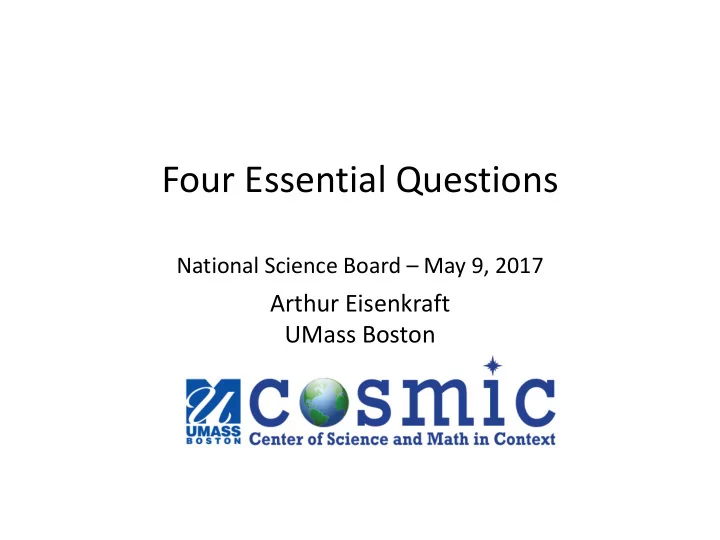

Four Essential Questions National Science Board – May 9, 2017 Arthur Eisenkraft UMass Boston
A story • Information challenge – $50 vs $10 – What is the height of Eiffel Tower? – What is both a mammal and a virus?
Where is the knowledge we have lost in information… T.S. Eliot
Four Essential Questions • What does it mean? • How do we know? • Why do we believe? • Why should we care?
The Essential Questions • What does it mean? » Newton’s 2 nd Law: F = ma » Energy is conserved » The Earth goes around the Sun » The atom has a nucleus » Mitochondria are the power house of the cell » H 2 O is a polar molecule (angle of 105) • Textbooks and classrooms are dominated by this question.
What does it mean? • Is the Earth Flat?
Artifacts of Science • A conversation with a principal – Order of the planets • “Science is a way of thinking much more than it is a body of knowledge.” - Carl Sagan • The science questions : What does it mean to say that Venus is closer to the Sun? How do we know that Venus is closer to the Sun?
The Four Essential Questions • What does it mean? • How do we know? » Newton’s 2 nd Law: F = ma » Energy is conserved » The Earth goes around the Sun » The atom has a nucleus » Mitochondria are the power house of the cell » H 2 O is a polar molecule (angle of 105)
The Four Essential Questions • What does it mean? • How do we know? » Newton’s 2 nd Law: F = ma » Energy is conserved » The Earth goes around the Sun • 80% know this • 49% know how long it takes • We have evidence for Venus being between us and the Sun; what about Earth going around the Sun? » The atom has a nucleus » Mitochondria are the power house of the cell » H 2 O is a polar molecule (angle of 105)
How do we know? • We accept carefully controlled experiments (or careful observations) as evidence of our understanding • “How do we know” unacceptable responses: – It is in the book – The teacher told us
Positivism • Is there only one truth? • Does experimental evidence provide the one and only interpretation of nature? • Can experimental evidence be interpreted in only one way? • The 3 rd Essential Question: – Why do we believe?
I need your help • Believe • How would you phrase the question – accept something as true – “Why do we believe?” – have trust where – have religious faith • It captures the meanings that I will outline • It is not misinterpreted to imply religious faith
Why do we believe? • The Nature of Science – Seat belts in the laboratory and seat belts in cars. – Mixing liquids today and mixing them tomorrow. – Cell structure in San Francisco and cell structure in Auckland. • The spectra of the Sun
Why do we “not” believe • We believe some things and don’t believe others. – People magazine - # pages – Woman giving birth – Umbrella • We have constructed filter systems after many years • This filter system is rarely articulated • We may not be able to communicate it – Polanyi -tacit knowledge
Why do we believe? • Active Physics 1. Does this content fit with other content in science? 2. Does this content fit with the big ideas of science? 3. Does this content meet the requirements of science?
Science vs Pseudo-science • Fields in physics vs auras • Predicting the future in science vs astrologers • Falsifiability The first three questions are good for academics: BUT this is not enough
The Essential Questions • What does it mean? • How do we know? • Why should I believe? • Why should I care? » Newton’s 2 nd Law: F = ma » Energy is conserved » The Earth goes around the Sun » The atom has a nucleus » Mitochondria are the power house of the cell » H 2 O is a polar molecule (angle of 105)
Why should I care? • Motivated students have higher achievement • Relevance to their lives now. • Why are we learning this? – This is chapter 14. – One day this will be useful • Not about “now” and therefore not about me • Not even true!
The Pendulum Lab With Motivation The story of Longitude (Dava Sobel) 20
Physics Olympiad Quantoons
Why Should I Care • Social Justice Issues – How many legs does a spider have?
Why should I care? “Education is not a preparation for life; education is life itself.” John Dewey
Why Should I Care • Active Physics – Project Based Learning – Physics of sports and “light and sound” shows • Active Chemistry – Project Based Learning – Chemistry of cooking and art • Competition programs – International Physics Olympiad • Quantoons – Duracell - Corporate Support – Toshiba ExploraVisions - Corporate Support
Thank You • National Science Board Public Service Award – Can it be Public Service when I have had such a good time? – I am not here to argue. – I am here to say thank you for deciding that it is.
Where is the knowledge we have lost in information… T.S. Eliot We can insure, through our teaching, that we value knowledge over information
Where is the knowledge we have lost in information… Where is the wisdom we have lost in knowledge? T.S. Eliot
Thank you. Email with questions/comments: arthur.eisenkraft@umb.edu .
Recommend
More recommend